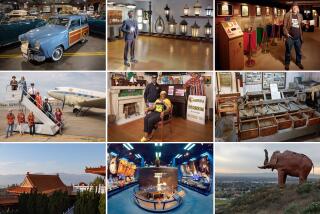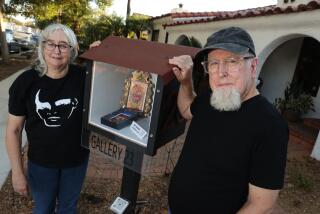Searching in a Small Town for a Cultural Trickle-Down
- Share via
NORTH ADAMS, Mass. — Last year, while officials of MASS MoCA were scrambling to get ready for their opening gala, blocks away Eric Rudd was scrambling to finish renovations on the Flatiron Building, which he hoped would be a prime beneficiary of the long-awaited art museum.
Rudd bought the dilapidated V-shaped building with a trickle-down vision: Staffers from the MASS MoCA complex would fill the cubbyhole apartments he created on the second floor, while some of the hoped-for hordes of museum visitors would wander over to sample four street-level galleries he was constructing. “We’re calling it Gallery Row!” he exclaimed.
In a time when there’s a lot of talk about the ability of cultural institutions to revive cities in need of a boost--of their economy or image--North Adams is high on the list of case studies. The idea of transforming abandoned brick factory buildings here into a museum goes back 15 years, the brainchild of Thomas Krens, then the director of the nearby Williams College Museum of Art. He went on to become head of the Guggenheim Museum and show how the revival process could work--in Bilbao, Spain. That’s where the Frank Gehry-designed Guggenheim branch put a struggling shipyard city on the world’s cultural map, drawing more than a million visitors a year.
Folks in this old Berkshire Mountains mill town hoped for a “Bilbao effect” when they finally got their Massachusetts Museum of Contemporary Art last summer, even if few understood the edgy art it featured, like the six maples (“Tree Logic”) hanging upside-down by the entrance. It was there, at MASS MoCA’s opening, that Gov. Paul Cellucci spoke of the museum bringing “a new life” to the city of 18,000.
A year later?
Not everything has unfolded as dreamed. When MASS MoCA opened, its director, Joseph C. Thompson, confessed that he’d love to attract 150,000 visitors a year. So far, the museum is running a third short of that, closer to its more sober feasibility projections. Out in the city, the profusion of galleries Rudd envisioned hasn’t materialized. One of the upside-down trees has even died.
But beyond that, there’s a bigger surprise: how much has happened.
Ticket sales in June ran 10% higher than last year and surged to nearly 6,000 a weekonce the Berkshires summer season got in full gear.
Talk of seeking “synergy” with nearby cultural institutions has proved to be more than talk. Free shuttle buses cart visitors between MASS MoCA and the Impressionist-filled Clark Art Institute and Krens’ old Williams College museum, just west in Williamstown.
There’s even a joint promotion with the Norman Rockwell Museum, 35 miles away in Stockbridge, inviting anyone who comes through its doors--or MASS MoCA’s--to “Visit the other end of the spectrum” by buying a discounted ticket to both.
*
As with the shuttle buses, the promotion is “not a whirlwind,” Thompson concedes, with only 20 to 25 people a week purchasing the joint tickets. But they’re trying, at least, to build a bridge between the avant-garde and Rockwell’s scenes of middle America.
The museum also has kept its promise to sponsor live entertainment in a town where there was little before, offering an event virtually every weekend evening in the summer. Not all have hit home--square-dancing fell flat--but polka packed ‘em in, and 500 people filled bleachers to see the silent film “Metropolis” with live orchestral accompaniment.
Also well past the talking stage is the museum’s plan to serve as a developer and landlord, renovating other buildings on its 13-acre site to attract commercial tenants. The same factory complex that once dyed textiles as Arnold Print Works (from 1860 to 1942) churned out capacitors as Sprague Electric (from 1942 to 1985) entered the New Economy when Kleiser-Walczak, an animation and special effects company, moved in last year. It has since been overtaken as the top commercial employer in the complex by eZiba.com, which sells hand-crafted products online.
While the seven commercial tenants there now provide only a fraction of the 4,000 jobs once generated by Sprague Electric, no one is quibbling in an area that not long ago suffered from one of the highest unemployment rates in the state. By September, 310 people are expected to be working in 60,000 feet of commercial space on the museum site--with more offices being readied. “I can lease just about anything we can build,” says Thompson, who is counting on the income to become the equivalent of a museum endowment, paying a third of the operating costs.
It’s already providing Eric Rudd with some trickle-down.
All 14 apartments in his Flatiron Building are filled--half to employees or interns at MASS MoCA, the rest to workers from the commercial tenants. “They’re fully booked all summer,” Rudd boasts.
A sculptor originally from Washington, D.C., he came here in 1988 looking for more space to create his enormous works, from clear polyethylene icebergs to a multisensory “Dark Ride Project.” He saw how thirsty the city was for any new venture when he inquired about an abandoned mill across town from the one earmarked as the future MASS MoCA. “My little letter made headlines,” Rudd recalls with a laugh. “ ‘D.C. Developer Interested in Mill Space.’ ”
He bought it for a song, and was able to get financial aid to help turn the 130,000-square-feet into the Contemporary Artists Center, with studios for painters and sculptors not yet embraced by the museum establishment.
Last year, after he bought the Flatiron Building to enable a “downtown presence”--a 10-minute walk from MASS MoCA--he spoke of how the world’s art crowds would make “pilgrimages” to North Adams, and how galleries and studios would pop up all over and how he might market an arts pass to visitors wanting to see them all.
That’s not here yet. To date, he has leased out one gallery in the first floor of the Flatiron and another “half gallery” that doesn’t have to be staffed. It’s not so easy, he acknowledges, to get outsiders to explore beyond MASS MoCA. “I’d like to see a little more linkage,” he says.
So last week he staged a second annual “Beach Party on Eagle Street” to bring people--and more art--to the city outside the museum.
Rudd got local contractors to donate sand and dump it by the street along the Flatiron. He later got the city to cart it away, for eventual use during winter snows. In between, local kids were invited to build sand sculptures--while artists from his Contemporary Artists Center displayed their works in nearby storefronts.
This summer, there was even a funding link between the center and MASS MoCA. The Lyda Ebert Family Foundation, which operates out of Cambridge and St. Helena, Calif., helped pay for the largest installation currently in the museum, a giant bagpipe created by Los Angeles artist Tim Hawkinson. Then the foundation helped bring in seven New England artists to spend three weeks at the Contemporary Artists Center to create works that involved the community.
*
That’s how Sarah Walker came to spend most of July in North Adams, on a project that tested how receptive residents really were to the movement to give an artsy make-over to their blue-collar, VFW Hall kind of city.
Walker, a 36-year-old Boston artist, set out to create a “portrait of North Adams’ collective unconscious--in doodles.” To do that, she distributed pads to shopkeepers and residents around town.
“Some were negative, very resistant,” she said. “Those folks were feeling threatened--it might be the death knell for their little businesses if the town was becoming more upscale.” A few thought she was patronizing them, like “I was implying they weren’t working hard enough and had time for this.”
But many scooped up her pads, and they came by the scores to the beach party, to see what she’d done with their doodles. Walker used a projector to blow them up, then recreated the patterns on clear strips of Mylar with opaque acrylic paint.
“It was fantastic,” she said afterward. “They all picked out their doodles. One woman came with a bag of cookies--snickerdoodles.”
Rudd, too, was elated by the event, which drew more than 700 people overall. “The whole street filled with sand! Art in storefronts! It’s bizarre,” he said. “This town is movin’!”’
So it may be. The latest development becomes a reality next summer, when a new inn replaces a sagging row of Victorian houses across from MASS MoCA on River Street. If the old North Adams was a Holiday Inn sort of place, this promises to be Berkshires chic: a $5-million 50-room bed-and-breakfast managed by the people who run the landmark Red Lion Inn in Stockbridge.
The instigator is John S. Wadsworth Jr., chairman of Morgan Stanley Asia Ltd. and one of the first major donors to MASS MoCA.
His project stemmed from a conversation with Thompson on a landing overlooking the gallery that now houses the giant bagpipe. The museum director shared the story the other day while a gray-haired couple, Dick and Mary Maynard, toured the exhibition and reminisced about the years when both worked in the factory, sometimes chasing rats with Coke bottles. Below, the bagpipe bellowed tunes as visitors passed motion sensors.
“We were looking onto River Street and [Wadsworth] said, ‘If I wanted to do something to help you but didn’t want to give you more money, what would you suggest?’ ”
“I said,” Thompson recalled, “ ‘Buy that block.’ ”
They called Nancy Fitzpatrick, who owns the Red Lion and sits on MASS MoCA’s board, “talked for two hours and struck a deal.”
Then the city’s mayor, John Barnett III, offered to convert an auto shop and car wash across River Street into a park.
That’s how things go in the new North Adams. And when the inn opens, Eric Rudd--to no one’s surprise--has an idea how they can go even further.
He wants an easier way to get people from the museum to his art center and the Flatiron Building.
“Bicycle rickshaws!” he said. “You just hop in at the front door. Twenty-five cents.”
More to Read
The biggest entertainment stories
Get our big stories about Hollywood, film, television, music, arts, culture and more right in your inbox as soon as they publish.
You may occasionally receive promotional content from the Los Angeles Times.










